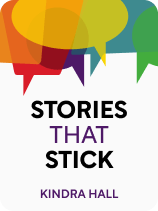

This article is an excerpt from the Shortform book guide to "Stories That Stick" by Kindra Hall. Shortform has the world's best summaries and analyses of books you should be reading.
Like this article? Sign up for a free trial here.
What is Kindra Hall’s Stories That Stick about? What are the main takeaways of the book?
In Stories That Stick, Kindra Hall discusses why stories are so powerful, explains what makes a good story, and introduces four core story models. She also includes prompts to help you build a stockpile of compelling stories.
Read below for a brief overview of Stories That Stick.
Stories That Stick by Kindra Hall
Never underestimate the power of a good story. According to Kindra Hall’s Stories That Stick, telling the right story is the answer to many of the challenges organizations face. Stories are the tool you need to build the connections that will enable your business to fulfill its purpose.
Hall is a professional speaker, author, and storytelling strategist. She’s delivered numerous keynotes and workshops for companies and organizations, including Coca-Cola, Hilton, and the United States Army. She’s also been featured in Entrepreneur, Forbes, and SUCCESS magazine. Hall is a board member of the National Storytelling Network and a contributing editor to SUCCESS. Stories That Stick was published in 2019.
The Role of Stories in Business
In the simplest terms, the purpose of any business is to provide people with something of value. But this isn’t as easy as it sounds, and businesses are always running into challenges in fulfilling that purpose. Hall argues that these challenges are actually disconnections, or gaps, where businesses fail to effectively engage their intended audience, whether that be customers, employees, or investors. For example, anytime a startup is struggling to find investors or a product isn’t selling, there’s a disconnection between the company and the intended audience. Hall argues that stories are the tool you need to build the connections that enable your business to fulfill its purpose.
Storytelling allows you to build connections in three ways:
1. Storytelling invites engagement because it’s a collaborative process. As you tell a story, the listener mentally fills in the gaps. They add images, feelings, and context to the details you provide. Instead of being lectured to, the listener is a participant in the storytelling.
2. Storytelling can inspire people to take action because stories are persuasive. Stories can shift perspectives and attitudes without people even realizing it, causing people to take action they wouldn’t have considered before hearing the story.
3. Storytelling has the power to produce lasting change. Virtuous stories, or noble stories, that are about something bigger than the story itself, are the stories that transform people.
How to Tell a Good Story
For a story to make an impact, it has to be a good one. Thankfully, according to Hall, there’s a simple recipe for crafting a compelling story. Good stories, she explains, must include four key components and follow a logical sequence.
The Four Components of a Good Story
According to Hall, all good stories have four key components:
First, good stories have a character that you’re rooting for—someone your audience can care about. The thing you’re selling, whether it’s financial consulting or the latest electric toothbrush, doesn’t count as a character because people can’t relate to a toothbrush. Make sure your story centers on a character that people empathize with.
Second, good stories rely on concrete details to paint a picture for the listener. This helps transport the listener to the world of the story, especially if those details are relatable and help the listener recall moments or details from their own life. For example, if you’re speaking to an audience born in the ’80s or ’90s, you might make a small reference to shared cultural experiences like Blockbuster or mix tapes.
Third, good stories are rooted in genuine emotion. While your story doesn’t have to be overdramatic, it does have to hold emotional weight. Otherwise, it doesn’t matter how the story ends. Make sure the audience has an emotional stake in the outcome.
Finally, good stories need a moment where something changes—a turning point. Stories without this pivotal moment are boring because they drift aimlessly without a clear purpose.
The Story Sequence
Now that you have the four elements of a strong story, you need a way to tie them all together. We’re taught from an early age that good stories have a beginning, a middle, and an end. But Hall recommends reimagining this three-part structure as a before (what she calls “the normal”), the change (“the explosion”), and the after (“the new normal”). This structure focuses on introducing tension or conflict that’s then resolved, thereby creating an engaging and more memorable story.
While often overlooked, the beginning of the story is critically important. In order to be emotionally invested in your story, your audience needs to know what the world looked like before everything changed. Your audience will be even more invested if that world, or the characters, is familiar to them. As you begin your story, introduce the characters and add the details that will help your audience connect to the world you’re describing. For example, if you’re speaking to a group of millennials, you could incorporate a reference to ’90s pop music or college debt—any detail that allows the listener to see themselves in your story.
The next part of the story is the moment when everything changes. It doesn’t matter whether the change in your story is good or bad; your story needs a moment where something happens that marks a difference between what happened before and what happens after. Otherwise, the story will be stagnant.
In the final part of the story, you describe what happens after the change—how does the central character or the world look different after the change, or how could it look different? For example, after someone buys your product, how is their life better?
The Four Core Stories
Even following Hall’s recipe for a good story, it can be intimidating to know how to choose the right story for the right occasion. Hall outlines four core stories that you can swap in depending on your audience and your intended goal: the Value Story, the Customer Story, the Founder Story, and the Purpose Story.
The Value Story
The Value Story is a useful tool when you want to increase sales or market to a new audience. According to Hall, the purpose of the Value Story is to communicate to your audience that you have the answer to their problem. It should articulate how your product or service will change your audience’s life for the better.
As with all good stories, when you tell a Value Story, follow Hall’s recommended structure—describe the before, the change, and the after. The before should address the problem that your audience is struggling with. The moment of change is when your product or service comes into the picture. Then wrap up your story by describing what happens next—how is life different or better now that your audience has your product or service in hand?
The 2019 Subaru Forester commercial, “A Parent’s Imagination,” is an example of a well-told Value Story. The ad begins by showing parents imagining the worst-case scenario of their teenager driving off the road or getting into a car accident because they are texting a friend or eating French fries. The problem: Parents are worried about their kids’ driving. But then, something changes—a distracted teenager is reminded by the Forester’s safety mechanism to “keep your eyes on the road,” allowing them to slam on the brakes just in time. The commercial ends with the child returning safely home and a mother breathing a sigh of relief. The message of the story is clear—you’re worried about your kids’ driving, but with this car, you don’t have to be.
This commercial also includes the four components of a good story—characters the audience can relate to (parents), specific details (parents looking out the window for their kids while washing dishes), strong feelings (anxiety and fear), and a turning point (the moment the car’s safety mechanism engages).
The Customer Story
The Customer Story serves much the same purpose as the Value Story. The only difference is that the story is told by the customers, not the company.
Customers’ stories are inherently more reliable than the polished stories produced by companies because they are real and unfiltered. Hall explains that the imperfections are what make the stories credible. The Customer Story can range from reviews posted on your website to interviews with real customers.
Warby Parker is a brand that strategically relies on customer stories in its marketing. To promote their home and virtual try-on options for glasses, Warby Parker compiled testimonials from real Warby Parker customers. In the videos, customers try on glasses while talking about the experience. The testimonials feel genuine because they are natural and unrehearsed. The cumulation of these testimonials tells the story that Warby Parker wants to tell—we make buying glasses easier.
Hall cautions that customer stories can be challenging because they’re harder to find and you have less control of the narrative. However, while you can’t control what customers say, you can strategically guide them to shape their testimonials into stories. For example, in the case of Warby Parker, the company might ask customers to talk about their previous experience buying glasses (the before) and then explain how Warby Parker is different (the change and the after).
The Founder Story
The Founder Story is useful when you’re courting investors, attracting new customers, or recruiting team members to your organization. According to Hall, the purpose of the Founder Story is to show what makes you stand out from the competition. This is the story of how your company began and the person behind it all. In this case, you’re not selling a product, you’re selling the person behind the company.
The Founder Story is more prescriptive than the other core stories. Your character must be the founder and the story should convey the passion and perseverance of that person. You want your audience to walk away impressed by how hard the founder worked to get where they are.
Procter & Gamble (P&G) is an example of a company that uses its Founder Story to inspire new employees to become more invested in the company and immersed in its culture. For instance, new P&G hires read “The Book,” which describes the company’s history and the founders’ core values, and new employees also take time to visit a life-size marble sculpture of William Cooper Procter, who was responsible for growing the Procter family’s business.
Hall emphasizes that you don’t have to be the founder to tell the Founder Story. If you don’t know your company’s founding story, ask! Then, as you retell it, talk about the first time you heard the founder’s story and how it impacted you. The founder’s story is valuable, regardless of who’s telling it.
The Purpose Story
The last of the core stories is the Purpose Story, which is useful when you want to bring people together around a shared vision.
Hall argues that storytelling helps align people around a shared purpose in three ways.
- Shared Challenges: A Purpose Story can remind people of their shared humanity, build trust, and open the door to productive dialogue.
- Shared Values: A Purpose Story can help people understand and connect with the values that guide the organization or community.
- Shared Vision: A Purpose Story can help people visualize a shared goal or future.
Patagonia is an example of an organization that uses all three strategies to organize people around a shared purpose. In their marketing, Patagonia communicates the shared challenges of overconsumption and climate change, the shared value of environmental responsibility, and the vision for a more sustainable clothing industry and healthier planet, which all contribute to Patagonia’s higher purpose—to protect the planet (and sell outdoor clothing).
Patagonia aligns people around what neuroeconomist Paul Zak refers to as a “transcendent purpose.” Citing Zak’s research, Hall explains that focusing on a transcendent purpose leads to deeper and more sustained levels of motivation and commitment. Focusing on a transactional purpose (exchange for goods and services), on the other hand, leads to shorter-term motivation and less fulfillment. In short, stories that speak to a deeper purpose are more likely to increase brand loyalty by helping customers develop an identity around your company.
How to Know What Story to Tell
At some point, you might need any one of the four core stories, but, according to Hall, the trick is finding the right story at the right time for the right purpose. She explains that to pick the right story, you need to be clear on the message you want to communicate and then find the story that most effectively articulates that message.
As you’re deciding what story to tell, Hall recommends considering the following questions:
- Who’s the story for?
- How do you want the story to change them?
For example, if you’re speaking to an audience of potential investors and you want them to feel confident about investing in your vision, tell your founder’s story. Help them see the resilience of the person behind the product. Or, if you’re speaking to customers and you want them to see that they are part of a global movement, tell a purpose story—connect them to the deeper meaning of your company.
How to Collect Stories
Hall argues that to effectively use stories to address the challenges facing your company, you need a stockpile of stories to choose from. Telling a compelling story, she explains, relies on having a bank of stories at your disposal and then pulling out the perfect story at the perfect moment. She recommends starting to build your story bank right away.
If you think this sounds intimidating, you’re not alone. According to Hall, many people go through life believing that they don’t have any stories to tell or that their stories aren’t worth hearing. Hall adamantly disagrees and emphasizes that everyone has stories worth sharing.
So where do you start collecting stories? Hall recommends brainstorming as many story ideas as possible without judging them or thinking about whether they’ll be useful. If you’re feeling stuck, write down a list of important people, locations, or objects, and see what comes up—many good stories are associated with them. Firsts or major obstacles are also often fruitful ground for storytelling. For example, think about the first time you made a public mistake or a time you accomplished something that seemed impossible.
You can also gather stories from other people. You don’t have to be the only source. You can build your list of stories by asking other people questions. Hall notes that general questions about an experience rarely elicit a worthwhile story (for example, “What was summer camp like?”). Specific questions are often more effective (for example, “Who was one of your closest friends at summer camp?”). If you plan on using someone else’s story, make sure you have permission first.
Stories are happening all around us, all the time. Now that you understand the power of storytelling, Hall recommends paying closer attention to the stories you hear so you don’t miss a particularly powerful story when it crosses your path. (Shortform note: There’s a growing appreciation for the power and prevalence of stories in our lives. This trend has been fueled by organizations like The Moth and StoryCorps, which have provided platforms for people to share their personal stories with a wider audience. The Moth stages live storytelling events and produces The Moth Radio Hour, while StoryCorps provides people with the opportunity to record, share, and preserve their stories. Both organizations have helped to raise awareness of the power of storytelling and have encouraged people to share their stories with others.)

———End of Preview———
Like what you just read? Read the rest of the world's best book summary and analysis of Kindra Hall's "Stories That Stick" at Shortform.
Here's what you'll find in our full Stories That Stick summary:
- Why stories are probably the answer to most of your business problems
- How to harness the power of storytelling to connect with your audience
- How to integrate storytelling into your marketing strategy






